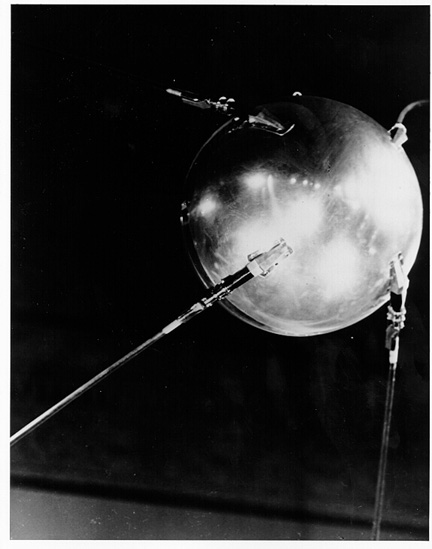 Sputnik’s 50th
Sputnik’s 50th
There is a strong argument that Sputnik is the reason the Pacific Science Center exists today.
Sputnik, the little, silver, antennaed ball with its classic “peep peep” radio signal, was launched on October 4, 1957. It marked the end of the first round of the Space Race, and lit a fire in the imaginations of people around the world, especially those in the United States. The unthinkable had happened: first, there was a man-made object circling around the Earth, and second, the Soviet Union had accomplished it first.

Credit: NASA
Caption: Sputnik
People everywhere heard the “peep peep” signal on their home radios (Sputnik broadcast at 20.007 MHz: a shortwave radio signal, that we now listen to on AM stations), and at night saw the star-like dot traveling across the sky. Suddenly outer space wasn’t just a dream in fantasy novels by Jules Verne. Within 15 years animals and people began spending time in space, and humans had touched the Moon.
Now that space was no longer a dream, we needed people to figure out how to get there and back again, safely. We needed rocket scientists. We needed materials engineers. We needed astronauts. We needed physicists, chemists, biologists, doctors, and veterinarians. In short, we needed all sorts of scientists to work on the space program – and everyone wanted to be part of it. Children around the world began to dream of being astronauts.
Building on this fervor, the United States Science Pavilion was constructed for “Century 21,” the 1962 World’s Fair. The pavilion showcased America’s scientific achievements, and inventions that pushed us further along in the Space Race with the Soviet Union. The public’s enhanced interest in science due to the Space Race made the pavilion a popular destination for visitors of all ages.
The day after the World’s Fair closed, the Science Pavilion was renamed, and opened to the public as Pacific Science Center. Though the space craze has faded over the years, Pacific Science Center continues to inspire a lifelong interest in science, mathematics and technology by engaging diverse communities through interactive and innovative exhibits and programs.
Want More?
http://history.nasa.gov/sputnik/ – You can hear the original “peep peep” at NASA’s site.
http://www.skyandtelescope.com/news/home/10206211.html – Sky and Telescope’s top story this month is all about Sputnik.




